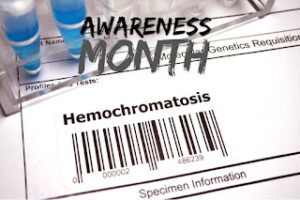Understanding Hemochromatosis: Symptoms, Diagnosis, and Awareness Month
In recent years, awareness surrounding Hemochromatosis has been steadily growing, shedding light on a condition that affects many individuals worldwide. Hemochromatosis is a disorder characterized by excessive accumulation of iron in the body, potentially leading to severe health complications if not addressed promptly. As we delve into the intricacies of this condition, let’s explore what it entails, when awareness is raised, and how it can be identified and managed effectively.

Hemochromatosis Awareness Month |
What is Hemochromatosis?
Hemochromatosis is a genetic disorder characterized by the body’s inability to regulate iron absorption efficiently. Normally, the body absorbs only the iron it needs from the diet, but in individuals with hemochromatosis, excess iron is absorbed and stored in various organs, particularly the liver, heart, and pancreas. Over time, this iron overload can result in damage to these organs and lead to serious complications such as liver disease, heart problems, diabetes, and joint pain.
Hemochromatosis Awareness Month
The campaign to raise awareness about Hemochromatosis takes place in July each year. During this month, efforts are intensified to educate the public about the condition’s prevalence, symptoms, and the importance of early detection and treatment. By spreading awareness, advocates aim to encourage individuals to undergo regular screenings, especially those with a family history of the disorder, as early diagnosis can significantly improve outcomes and prevent complications.
The Gray Ribbon: Symbol of Hemochromatosis Awareness
Gray is the designated color for Hemochromatosis Awareness Month. Symbolically, this hue represents the condition’s gravity, reminding us of the importance of understanding and addressing iron overload. Through the gray ribbon, individuals affected by hemochromatosis and their supporters stand united in their mission to raise awareness, promote early detection, and support ongoing research efforts.
Show your support for Hemochromatosis Awareness with our gray ribbon campaign t-shirt. Featuring a sleek design, this shirt spreads knowledge about iron overload and promotes early detection. Wear it proudly in July and all year round to help raise awareness and support research efforts. Together, we can make a difference!
|
|
| Hemochromatosis Awareness Month |
Recognizing the Symptoms
Identifying hemochromatosis early is crucial for effective management and prevention of complications. While symptoms may vary among individuals, common signs of hemochromatosis include:
- Fatigue and weakness
- Joint pain and stiffness, especially in the hands
- Abdominal pain
- Unexplained weight loss
- Changes in skin color, such as bronze or grayish tint
- Loss of libido or impotence
It’s important to note that not everyone with hemochromatosis will experience symptoms, especially in the early stages of the condition. Therefore, routine screenings for iron levels are recommended, particularly for individuals with a family history of the disorder.
Diagnostic Criteria
Diagnosing hemochromatosis typically involves a combination of medical history assessment, physical examination, and laboratory tests. Key diagnostic criteria include:
- Serum Iron Levels: Elevated levels of serum iron, along with high transferrin saturation, are indicative of iron overload.
- Ferritin Levels: Ferritin, a protein that stores iron, is often elevated in individuals with hemochromatosis.
- Genetic Testing: Genetic analysis can identify mutations in the HFE gene, which is associated with the majority of cases of hereditary hemochromatosis.
- Liver Biopsy: In some cases, a liver biopsy may be performed to assess the extent of iron accumulation and detect any liver damage.
By promptly diagnosing hemochromatosis and implementing appropriate management strategies, such as therapeutic phlebotomy to reduce iron levels, individuals can effectively control the condition and minimize its impact on their health.
Conclusion
As we observe Hemochromatosis Awareness Month in July, let us join hands in spreading knowledge and understanding about this often-overlooked disorder. Through education, early detection, and ongoing research, we can empower individuals affected by hemochromatosis to lead healthier lives and prevent the devastating consequences of untreated iron overload. Together, we can make a difference in raising awareness, advocating for better screening practices, and ultimately improving outcomes for those living with hemochromatosis.

